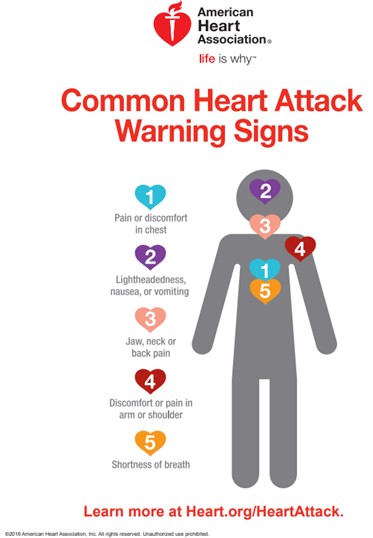Critical Illnesses: Cardiac Conditions and Cerebral Vascular Disease
Table of Contents
What are the Common Symptoms of a Heart Attack?
What are the Main Causes of a Heart Attack?
What are the Common Symptoms of a Stroke
What are the Main Causes of a Stroke?
What are the Common Symptoms of a Brain Aneurysm
What are the Main Causes of a Brain Aneurysm?
Heart Attack
What is a Heart Attack?
A heart attack occurs when the blood flow to a part of the heart muscle doesn’t get enough blood.
What are the Common Signs of Heart Attack?

- Pain or discomfort in chest
- Lightheadedness, nausea, or vomiting
- Jaw, neck, or back pain
- Discomfort or pain in arm or shoulder
- Shortness of breath
In addition to those, women may also experience an unusually tired feeling.
What are the Main Causes of a Heart Attack?
Coronary artery disease is the main cause of heart attacks. When plaque builds up in our arteries, our risk for a heart attack increases. As plaque continues to build, blood has less room to flow, and eventually the plaque can erupt. Sever spasms or sudden contractions of a coronary artery can also stop blood flow to the heart muscle and cause a heart attack, but this is less common.
Stroke
What is a Stroke?
A stroke involves an interruption of blood flow in the brain.
Three main types of strokes: Ischemic, Hemorrhagic, and Transient Ischemic Attacks
Ischemic strokes are the most common type and occur when blood flow through the artery that supplies oxygen-rich blood to the brain becomes blocked, usually because of a blood clot.
Hemorrhagic strokes occur in the brain. An artery in the brain leaks blood or breaks open, and the leaked blood puts too much pressure on brain cells. The two types of hemorrhagic strokes are:
- Intracerebral. Most common. Occurs when an artery in the brain bursts, flooding the surrounding tissue with blood.
- Subarachnoid. Less common. Refers to bleeding in the area between the brain and the thin tissues that cover it.
Transient Ischemic Attacks (TIAs) are sometimes referred to as “mini-strokes.” The blood flow to the brain is blocked only for a short time, usually about 5 minutes or less. TIAs are usually a warning sign of a future stroke, and although referred to as a “mini-stroke” are still a medical emergency and require emergency care.
What are the Common Symptoms of a Stroke?
Remember B.E. F.A.S.T.
Balance. Has the person suddenly lost their coordination or balance?
Eyes. Is the person suddenly experiencing double vision or vision loss in one or both eyes?
Face. Is one side of their face drooping? Ask the person to smile.
Arms. Is one arm drifting downwards? Have the person raise both arms in the air.
Speech. Is their speech slurred or are they having difficulty getting the words out? Have the person repeat a simple phrase.
Time. If the person is experiencing or showing any of these symptoms, call 9-1-1 and get them to the hospital immediately.
Additional Symptoms
- Sudden numbness or weakness of the leg
- Sudden confusion or trouble understanding
- Sudden severe headache with no known cause
What are the Main Causes of a Stroke?
High blood pressure, high cholesterol, smoking, obesity, and diabetes.
Brain Aneurysm
What is a Brain Aneurysm?
A ballooning or bulge in a blood vessel in the brain, usually caused by a weakness in the walls of the blood vessel. It isn’t always clear, however, what causes the weakness.
What are the Common Symptoms of a Brain Aneurysm?
Unruptured Aneurysm
- Loss of vision or double vision
- Pain above or around the eyes
- Numbness or weakness on 1 side of the face
- Difficulty speaking
- Headaches
- Loss of balance
- Difficulty concentrating or problems with short-term memory
Leaking Aneurysm
An aneurysm may leak a slight amount of blood, but a severe rupture often follows leaking.
- Sudden, extremely severe headache
Ruptured Aneurysm
- Sudden, extremely severe headache – often described as “the worst headache ever”
- Nausea and vomiting
- Stiff neck
- Blurred or double vision
- Sensitivity to light
- Seizure
- A drooping eyelid
- Loss of consciousness
- Confusion
While most brain aneurysms don’t rupture or cause health problems or symptoms, a ruptured aneurysm quickly becomes life-threatening and emergency medical treatment is needed.
What are the Main Causes of a Brain Aneurysm?
The cause is generally unclear, but some factors can increase the risk for a brain aneurysm to develop.
- Older age
- Cigarette smoking
- High blood pressure (hypertension)
- Drug abuse, particularly the use of cocaine
- Heavy alcohol consumption
This blog post is for informational purposes only. It is not intended to diagnose or treat any conditions or illnesses or act as a substitute for professional medical advice. Consult your healthcare provider if you have concerns about your health.
- CDC. Heart Disease. Heart Attack Symptoms, Risk, and Recovery.
- CDC. Stroke. Types of Stroke.
- Stroke.org. Stroke Symptoms.
- Mayo Clinic. Brain aneurysm. Overview.
- American Heart Association.